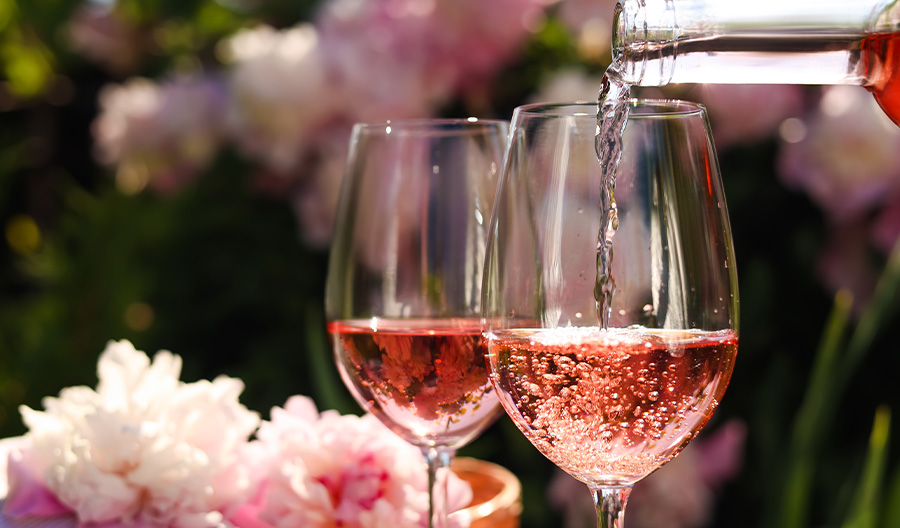Rosé is a wine with surprising nuance that encompasses impressive traditions in some of Europe’s great appellations. However, it’s not so complex that it’s intimidating to learn the basics. Rosé is the fastest-growing category in America, as consumption grew roughly 50% in 2022.
Here’s a breakdown of the differences in rosé, from the effect harvest and production techniques have on style, color, and taste, to a review of classic regions. Next time your customers reach for a bottle, they'll know what’s inside if it says Tavel, rosado, or rosato.
How rosé is made
Many believe that all rosé is a blend of white and red wine, but most bottles are the result of skin contact or as a “saignée.” Blending red wine with white is only common in rosé Champagne. Another misconception left over from America’s white Zinfandel days is that rosé is off-dry or even sweet. Most quality-driven European rosés are dry, as are offerings from an increasing number of New World producers.
Elegant and flavorful, this delightfully hued Brut Rosé opens with aromas of ripe raspberries, rose petals and a savory note of slivered almonds. Luscious notes of fresh mandarin orange, strawberries and crème fraîche alight the palate, as lively acidity and steely minerality frame a crisp, lingering finish.
Skin contact
Have you ever heard the phrase “intentional rosé”? It refers to grapes grown and harvested to explicitly make rosé wine. It features an early harvest to preserve the grape’s vibrant acidity and bright fruit flavors, followed by a limited maceration.
The maceration process is the same that winemakers follow for red wine, where they crush grapes and allow the juice time on the skins. But for rosé that time is far less, ranging from a few hours to a week. The shorter the period, the lighter the color. After maceration, the wine is drawn off and fermented to full dryness.
Direct press is a variation that helps make very pale rosés from darker skinned berries, though the style is more akin to white winemaking than red. Rather than allow a maceration period, the grapes are pressed and the juice is immediately drawn off the skins. However, as the skins break during pressing, the juice will take on a hint of color and flavor. This method yields a delicate rosé, one that’s faint in color and favors citrus flavors over red fruits.
Saignée
French for “to bleed,” saignée is often a byproduct of red winemaking, rather than an intentionally made rosé wine. This technique is common in regions where winemakers seek to produce concentrated, bold reds with big flavor.
Bleeding some wine off early in the maceration process helps concentrate the remaining juice. The lighter juice that’s bled off is vinified separately as rosé, resulting a more deeply colored style of wine. Saignée is great for those who prefer a richer, fruitier style of rosé.

Do they blend wines together?
Except for perhaps during the late stages of a raucous party, fine wine producers don’t blend red and white wine to make rosé. French appellations don’t allow it, except for Champagne. For rosé Champagne, producers may add still Pinot Noir or Pinot Meunier for hue and flavor. Outside of Europe, a few New World producers might blend white and red, but it’s not the norm for quality wine production.
French rosés
Provence
If you’ve sipped a glass of rosé, you’ve probably tasted one from Provence. Denizens in the South of France view rosé as not just a beverage, but a way of life. Stylistically, Provençal rosé is quite distinct.
Typically, these rosés are made intentionally, picked for citrus and tart red fruit flavors with limited skin contact for lighter hues and delicateness. They’re not big, brash, fruity wines, but meant to be crisp and versatile. They can be enjoyed with vegetables, seafood and even meat.
The classic Provençal rosé grapes are Grenache, Cinsault and Mourvèdre. Wines from the Bandol region of Provence have a large presence in the U.S., primarily high-quality, pricier rosés made from predominantly Mourvèdre. These wines are savory, mineral-driven and structured, rather than simple and fruit-forward. Bandol is a rosé that can age.
Mostly based on Cabernet Franc, the best rosés weave delicate herbal notes from the Cab Franc with juicy red fruit flavors.
Spaniards have enjoyed rosé for ages, which they call rosado, but only in recent years have those bottles gained popularity stateside. Traditionally, producers made simple, quaffable wines. But as exports have increased, so has quality. Grenache and Tempranillo are the main grapes used to make various styles, though often in a deeper hue than their French counterparts.
Rioja
Unusual in the world of rosé are aging classifications. Most rosé producers tout new vintages for their youthfulness and freshness, aided through the use of stainless steel vessels. But in the case of Rioja, rosado follows the classic aging rules in oak barrels: joven (no aging requirement), crianza (aged for 12 months, with six months in barrel); and reserva (two years with six months in barrel). Grenache and Tempranillo are the primary grapes.
Known as rosato in Italy, rosé is made throughout the country with styles and flavors dependent on the local climate and traditional varieties. You’ll find more delicate versions produced in the cooler northeast around Veneto, Friuli-Venezia Giulia and Trentino-Alto Adige. That includes Chiaretto from Lombardy and Veneto. Chiaro means “light” or “pale” and evoke the dry style of the wine based on the Corvina grape. Ramato, from Friuli, is based on extended maceration with pink grape Pinot Grigio.
Central Italy produces one better-known rosatos: cherry-pink Cerasuolo d’Abruzzo made from the Montepulciano grape.
In the south, rosatos are fuller-bodied and flavored, much in the same manner as the region’s food and intense sunshine. Puglia, Sicily, and Calabria turn out lots of examples with native grapes like Negroamaro (Puglia) and Nero d’Avola (Sicily).

